In the latest highly successful edition of the Biografilm Festival in Bologna (9-19 June 2023) a section was dedicated to the visual art and experiments by Rä di Martino, video artist and director, which ranges from installations, tableaux vivants, source materials, film, acting and memoir. The charming Rä, was born in 1975 in Rome. Her father was a Milanese musician and her mother a theater actress. And it was her father, a composer of songs for various Italian artists, who gave her this particular first name in honor of Sun Ra, an American jazz musician famous in the 1970s and 1980s. The artist says that Rome is her city, and that she has returned to it after 22 years on the road.
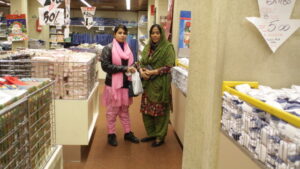
Rä di Martino, The Show MAS Go On, video still, 2014, courtesy of the artist
In particular, she lived in England, where she studied at the Chelsea College of Art and at the Slade School of Art and then in New York, where she stayed for a long time consolidating her international career. In fact, the young Rä has exhibited in prestigious museums, including the Tate Modern in London, the MoMa-Ps1 in New York, MCA in Chicago, Palazzo Grassi in Venice, GAM in Turin, MACRO and MAXXI in Rome and many others. With her works she has participated in various festivals such as Locarno, New York, Turin, Venice, Florence, Basel. And no less important is the homage of Biografilm, founded 19 years ago by Andrea Romeo and directed by Massimo Mezzetti, where several of his works from different periods were proposed, including fiction and documentaries, very formal and characterized by a personal exploration of reality and of fiction. Among the ten films and videos, her first documentary was proposed, “The Show MAS Go On”, which at the Venice International Film Festival in 2014 had won the Silver Ribbon for best documentary film. The documentary (30′) was made with the participation of some actresses, including Maya Sansa, Iaia Forte, Sandra Ceccarelli, documenting the MAS department stores. Interesting and experimental “If You See the Object, the Object Sees You”, a video made in 2010 after Rä had visited the extraordinary home-studio of Yona Friedman (1923-2020), Hungarian architect and designer, naturalized French in Paris. The space filled with heterogeneous objects fascinated her and led her to observe the models of the designer, famous for having founded the Mobile Architecture Study Group (MASG) and for his visionary and utopian ideas on urban spaces. Very different “Fuori dai teatri” (2021) a 30′ documentary focused on the memories and stories of the founders of the famous Center for Experimentation and Theater Research in Pontedera and interpreted by the actors Anna Bellato and Lino Musella.
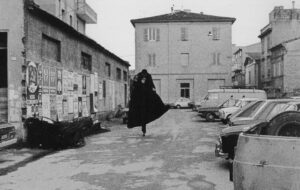
Rä di Martino, Fuori di Teatri, 2021, video still, courtesy of the artist & Teatro Era, Pontedera
Evocative and sophisticated “Il giardino che non c’è” (2021), a documentary that tells the genesis of the book “Il giardino dei Finzi-Contini” (1962) by Giorgio Bassani analyzing, with archive images and interviews with Dominique Sanda and Lino Capolicchio, the artistic relationship between the novel and the beautiful film by Vittorio De Sica. The docufilm offers a very personal vision of an illusory place, which has become almost real in the perception of the public with the success of the film: a perfect and imaginary place lived by beautiful and middle-class young people, while outside the wall looms the imminent threat of the Nazi-fascists. As with the other works present at Biografilm, the gaze of the Roman artist has an experimental approach to the theme of memory, investigating physical and mental places, with a fluid montage that promptly brings us back to the present.
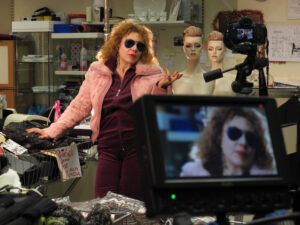
Rä di Martino, The Show MAS Go On, 2014, Iaia Forte on set, photo Sveva Bellucci, courtesy of the artist
Manuela Teatini: How do you experience the successful double commitment between your work as an artist and that of a documentary filmmaker?
Ra di Martino: As far as I’m concerned, this split between artist and director gives me a lot of energy, because it always helps me rebalance my energies. Obviously I work much less as a director because I’m much slower. With films I have to take care of all the relationships, I have to find out everything, because it’s a very collaborative work and I always try to co-produce too so as not to lose control, and that’s the thing that scares me the most. I must also say that when a project ends up in a cinema, I am very happy: the tension is stronger and more enveloping because the large images give more prominence to the detail. But after a while I really miss the museum context, the possibility of being in a space and creating works that go into that environment. So they are really two worlds close but far away and I have to say I like them both despite being difficult. They have different audiences and different ways of thinking… As an artist I also look back at the history of art and at other artists.
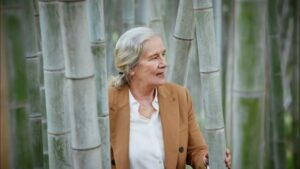
Rä di Martino, Il giardino che non c’è, 2021, Dominique Sanda on set, photo Alessandro Cantarini , courtesy of the artist
Among the video artists, do you have anyone in particular as a reference, and how did your passion for this artistic expression start?
My passion didn’t start from a love for someone because as a child I actually wanted to be a director but instead I ended up in an art school. But I was born from the cinema. If I have to tell you among the good old artists I am very close to Michael Snow (1928-2023) because he deconstructs language in a way that interests me, then while I was studying in London I was connected with the Young British Artists, that was their moment. Not everyone convinced me, but for example I really liked Gillian Wearing, together with something by Tracey Emin and therefore I am very attached to that group. For me the references in art are all English, video art arrived there before it did here. I don’t feel close to Italian art because I haven’t lived with it, while I trained much earlier in Rome with Italian cinema from the 1960s and 1970s and international cinema.e.
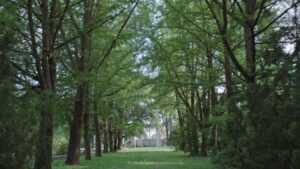
Rä di Martino, Il giardino che non c’è, video still, 2021, courtesy of the artist
I understand that in any case you feel much more of an artist and that English and then American international art has shaped you profoundly.
Yes, of course I’ve always been an artist, but I’ve always wanted to do cinema stuff, so I go slower with this medium and take long breaks.
Was the film “Il giardino che non c’è” born out of your passion for De Sica’s film or a work of art?
No, that was born for a commission. They called me right from out of the blue, Italian producers who produced with the “Arté” television in France. They thought of me for some reason and so I decided to take up the unusual challenge of making a documentary about a book for television. It was a new experience, where I also tried to put some of my material, making a compromise with the producers of “Arté”. The film went to the Turin Film Festival, but in Italy it was not distributed on television, paradoxically it was only released in Germany and France.
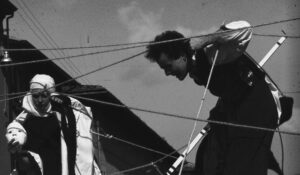
Rä di Martino, Fuori di Teatri, 2021, video still, courtesy of the artist & Teatro Era, Pontedera
How did “The Show MAS go on” come about?
That was born because we thought that the MAS department store was about to close, we threw ourselves in without money, in reality then they took six seven months to close. While we were filming we were looking for financing, we did it very cheaply, but it was a lot of fun. While I was documenting I was also writing the scenes for the almost acted inserts. Then there are cameos from some actors. We had a lot of fun.
Among the contemporary directors of international cinema who do you Among the contemporary directors of international cinema who do you like?
I’m a big fan of Jim Jarmush, and the older his films are, the more I like them. Then Ruben Östlund, a genius! He is very ironic and only he has managed to talk about the art world in an almost “neorealist” way.
Info:
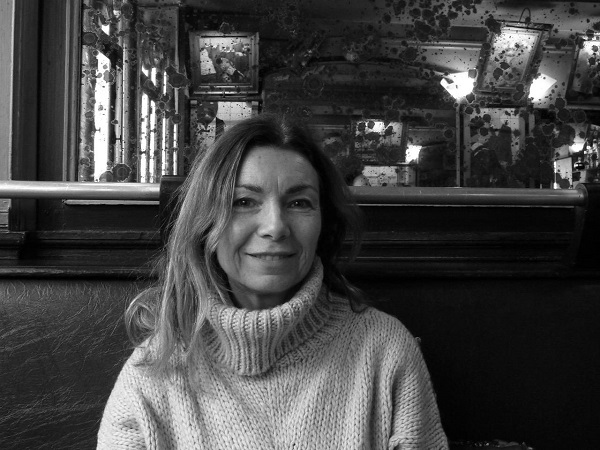
Manuela Teatini, film maker and journalist, focuses on visual arts, in particular cinema, photography and contemporary art. She has written freelance for years with VOGUE, Uomo VOGUE, ELLE and other cinema, art and new trend magazines. She is the author and director of the docufilms “ART BACKSTAGE. La passione e lo sguardo” (2017),” MASSIMO MININI. Story of a Gallerist “(2019),” GIOVANNI BOLDINI. Il Piacere. Story of the Artist” (2021) awarded at the Terra di Siena International Film Festival 2021.






NO COMMENT